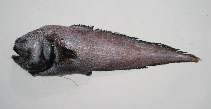| Family: |
Ophidiidae (Cusk-eels), subfamily: Neobythitinae |
| Max. size: |
57 cm TL (male/unsexed) |
| Environment: |
bathydemersal; marine; depth range 984 - 2500 m |
| Distribution: |
Possibly worldwide in tropical and subtropical seas (but not yet caught in the eastern Pacific) (Ref. 34024). Eastern Atlantic: 2 specimens between 12°N and 9°25'N. Western Atlantic: Gulf of Mexico to off southern Brazil. Northwest Pacific: Ashizuri Cape, Japan. |
| Diagnosis: |
Dorsal soft rays (total): 89-89; Anal soft rays: 74-74. Body and tail strongly compressed, snout round and short, no spine on tip. Head and body uniformly whitish, margins of median fins light brown, jaws, pelvic fins, mouth and gill cavities deep brown. Peritoneum and stomach deep brown, intestine yellowish. |
| Biology: |
A benthopelagic species at bathyal depth (Ref. 56809). Found on the continental slope (Ref. 75154). Rare species (Ref. 34024). Reproductive strategy possibly similar to other members of this family featuring oviparity, with oval pelagic eggs floating in a gelatinous mass (Ref. 205). |
| IUCN Red List Status: |
Least Concern (LC); Date assessed: 11 October 2018 Ref. (130435)
|
| Threat to humans: |
harmless |
| Country info: |
|
Source and more info: www.fishbase.org. For personal, classroom, and other internal use only. Not for publication.

